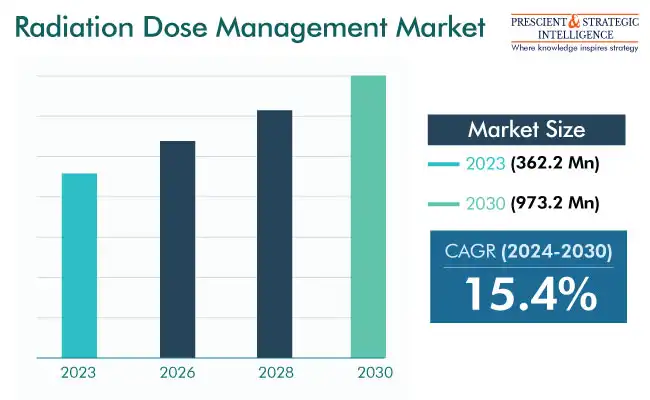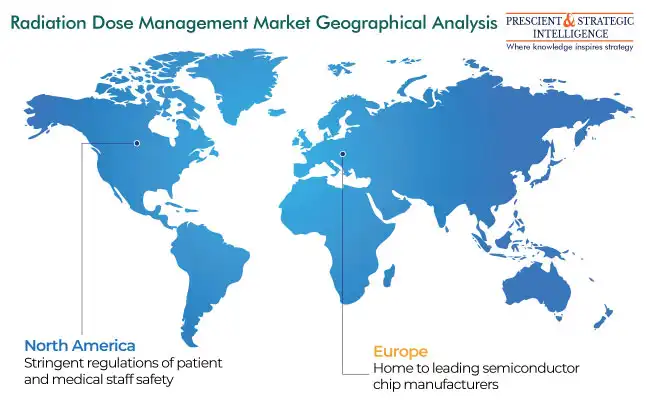Report Code: 11197 | Available Format: PDF
Radiation Dose Management (RDM) Market by Product & Services (Solutions, Services), by Modality (Computed Tomography, Nuclear Medicine, Fluoroscopy & Interventional Imaging, Radiography & Mammography), by End User (Hospitals, Super Speciality Clinics), by Geography (U.S., Canada, Germany, France, U.K., Italy, Spain, Japan, China, India) - Global Market Size, Share, Development, Growth and Demand Forecast, 2013-2023
- Report Code: 11197
- Available Format: PDF
- Report Description
- Table of Contents
- Request Free Sample
Radiation Dose Management Market Size & Share
The radiation dose management market estimated value is USD 362.2 Million (E) in 2023, and it will propel at 15.4% compound annual growth rate during 2024–2030, to reach USD 973.2 Million by 2030.
This growth is because of the increasing worries associated with radiation exposure and the growing incidence of cancer requiring radiation therapy. For instance, as per Cancer Research UK, there will be 28 million new cases of cancer globally each year by 2040, if occurrence remains constant and aging and population growth continues consistent with recent trends.

Moreover, as per the WHO, over 50% of cancer patients need radiotherapy during their cancer care procedures. However, radiotherapy access is inadequate, mainly in low- & middle-income nations.
Radiation therapy is an important branch of medical science. Different diseases such as cancer, cardiovascular diseases, and others are diagnosed and treated using electromagnetic waves. It is widely used in the treatment of various forms of cancer. But radiation therapy also has side effects. Thus, dose monitoring is very critical in any radiation-based medical procedure. The radiation dose is referred to as the radiation that is thrown at the patient.
Radiation dose management includes information on software used for recording radiation doses; real-time staff dose monitoring; compliance with the regulations; and dose reduction technologies, including interactive reconstruction software.
Increasing Worries Regarding Radiation Exposure Is Major Driver
The patient’s exposure to radiation in the last two decades has significantly increased. Higher radiation exposure concerns include the increasing utilization of medical imaging procedures, including CT scans, nuclear medicine, and X-rays, in a wide variety of medical specialties. Precise diagnosis and treatment planning demand more imaging procedures, intensifying the spread of radiation-induced side effects, including cancer risk.
Consequently, the government has come up with stricter guidelines and regulations by regulatory bodies and healthcare organizations to limit radiation doses and ensure patient safety. In addition, AI and ML integration into radiation dose management systems is improving accuracy through the processing of large datasets and tailoring radiation exposure according to patient-specific features. This has addressed radiation overexposure issues in the area of radiation dose management.
- The European Council Basic Safety Standards Directive (BSSD), or the European Directive 2013/59/Euratom, creates basic safety standards for protection against the hazards of exposure to ionizing radiation.
- Moreover, as per the International Atomic Energy Agency (IAEA) in December 2023, the intergovernmental organization is set to develop new standards for radiation protection & safety in current exposure situations
Latest Trends
- Increasing Acceptance of Cloud-Based Solutions: The popularity of cloud-based radiation dose management solutions can be attributed to the fact that they are scalable, low-cost, and easy to use. These solutions are removing the need for on-premise hardware and software hence the most suitable solutions for small and medium-sized health providers.
- Incorporation with Imaging Modalities: Radiation dose management solutions are being combined with imaging modalities including X-rays, fluoroscopes, and CT scanners. This incorporation enables real-time dose tracking and adjustment, thereby minimizing patients’ radiation exposure.
- Growing Emphasis on AI: Artificial intelligence is being employed to create innovative radiation management approaches that can identify and enhance imaging protocols automatically. These remedies can also enable patient’s radiation exposure to be minimized even further and enhance image quality.
- For instance, in November 2023, ConcertAI and Clinical Artificial Intelligence Imaging Interpretation announced their collaboration with Memorial Sloan Kettering Cancer Center under a multi-year strategic partnership.
- This collaboration aims to accelerate the development and adoption of Clinical AI algorithms and integrated imaging workflows for improving clinical trials and improving the oncology clinical decision-making process.
| Report Attribute | Details |
Market Size in 2023 |
USD 362.2 Million (E) |
Revenue Forecast in 2030 |
USD 973.2 Million |
Growth Rate |
15.4% CAGR |
Historical Years |
2017-2023 |
Forecast Years |
2024-2030 |
Report Scope |
Market Trends, Drivers, and Restraints; Revenue Estimation and Forecast; Segmentation Analysis; Impact of COVID-19; Companies’ Strategic Developments; Market Share Analysis of Key Players; Company Profiling |
Explore more about this report - Request free sample
Global Lack of Benchmarking for Dose Optimization Is Key Challenge
The efficient utilization of the radiation dose management software for reducing doses is limited by the government's lack of defined standards and standardized processes for the radiation dose benchmark of all radiology procedures. At the global level, there is no standard protocol for all types of examinations, imaging modalities, and patients of all sizes, and age groups. As such, the absence of global benchmarking standards is a major challenge to the development and performance of radiation dose management solutions whose limitations hamper their ability to tackle the rising incidence of patients’ radiation exposure during medical imaging interventions.
CT Is Leading Modality Category
The computed tomography (CT) category, based on modality, led the industry. The leading share of this category is because of the rising prevalence of targeted diseases, including cardiovascular diseases and cancer, for monitoring as well as diagnosis.
As per the WORLD HEART REPORT 2023:
- Globally, deaths from cardiovascular disease increased from 12.1 million to 20.5 million between 1990–2021.
- Approximately 4 in every 5 cardiovascular deaths happen in low- & middle-income countries.
In addition, stringent rules for patient safety & compliance with legislative and accreditation necessities have enforced medical providers to accept CT scans and radiation dose management solutions.
Hospitals Is Dominating Market
The hospitals category, on the basis of end user, led the industry. This can be mainly because of the increasing adoption of telehealth and teleconsultation in the medical providers community, targeting to lessen the stress on healthcare facilities. Moreover, the suitability offered by radiation dose management solutions allows medical professionals to swiftly access patient dose records, enable real-time dose exposure, and improve data management. As a result, fostering a bigger acceptance of these services among medical providers.
North America Is Market Leader
North America is the largest contributor to the industry. The strong growth of the regional industry is primarily because of significant healthcare IT expenses as well as the high penetration of advanced radiation software solutions.
- As per the U.S. Centers for Medicare & Medicaid Services (CMS), the healthcare expenditure of the nation grew 4.1% to touch USD 4.5 trillion in 2022. A faster rate compared to the growth of 3.2% in 2021.
The continent's advantageous conditions, such as the existence of major players and the arrival of startups, will further boost the growth of the industry in the coming years.
Europe accounted for the second-largest share of the industry, because of the government initiative to enhance patient safety, the incidence of chronic illnesses, and rising healthcare spending. Moreover, the increasing consciousness regarding radiation dose safety through conferences and campaigns is also aiding the growth of the industry in this region.

Competitive Landscape
The radiation dose management market is likely to remain fragmented in the years to come. However, the leading companies will continue to reinvest in R&D to develop new products and increase market share.
Some Major Players in the Radiation Dose Management Market:
- Philips Healthcare
- Bayer AG
- Sumitomo Mitsui Financial Group Inc.
- Canon Inc.
- Toshiba Corporation
- Sectra AB
- PACSHealth LLC
- Qaelum N.V.
- Bracco Imaging S.P.A.
- Dedalus S.p.A.
- Novarad Corporation
- Nanjing Perlove Medical Equipment Co. LTD.
- Siemens AG
- General Electric Company
- IG Farben
Recent Development
- In May 2023: IBA, a major provider of radiation therapy quality assurance, introduced DOSE-X, the next-generation reference class electrometer, at ESTRO 2023.
- In October 2022, Aspekt Solutions declared the acquisition of the Therapy Physics business of Landauer (a physics & dosimetry services provider to radiation oncology clinics across the U.S.). This incorporation will create one of the largest independent groups in the U.S.
Want a report tailored exactly to your business strategy?
Request CustomizationWant an insight-rich discussion with the report author?
Speak to AnalystOur dedication to providing the most-accurate market information has earned us verification by Dun & Bradstreet (D&B). We strive for quality checking of the highest level to enable data-driven decision making for you
Our insights into the minutest levels of the markets, including the latest trends and competitive landscape, give you all the answers you need to take your business to new heights
With 24/7 research support, we ensure that the wheels of your business never stop turning. Don’t let time stand in your way. Get all your queries answered with a simple phone call or email, as and when required
We take a cautious approach to protecting your personal and confidential information. Trust is the strongest bond that connects us and our clients, and trust we build by complying with all international and domestic data protection and privacy laws